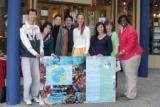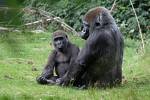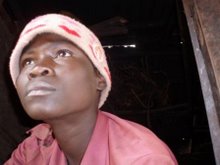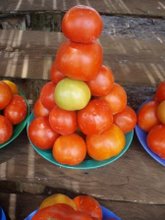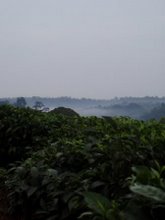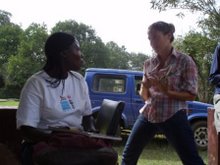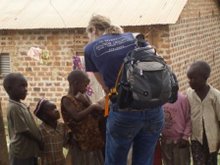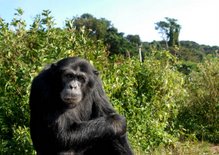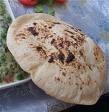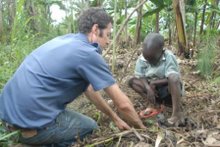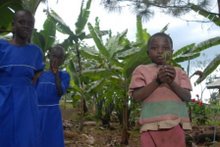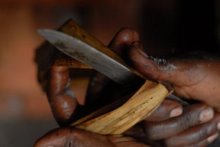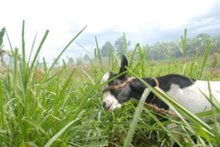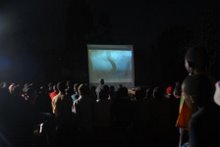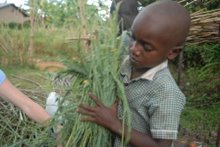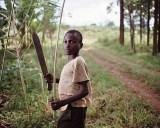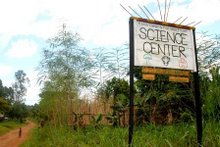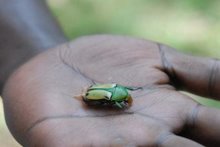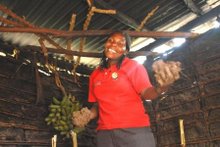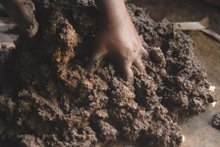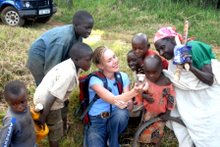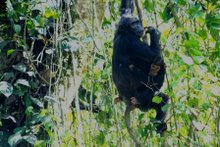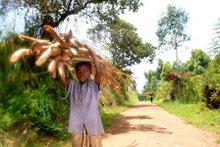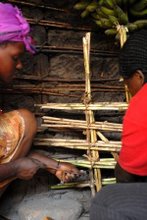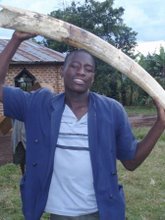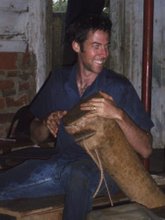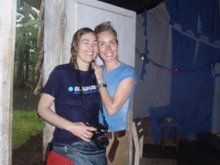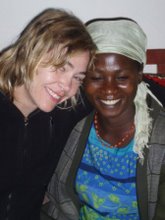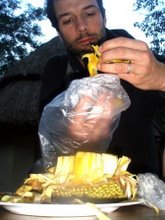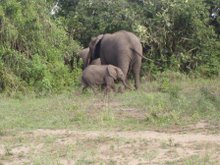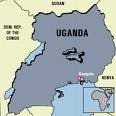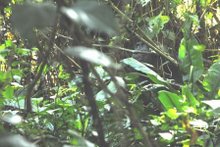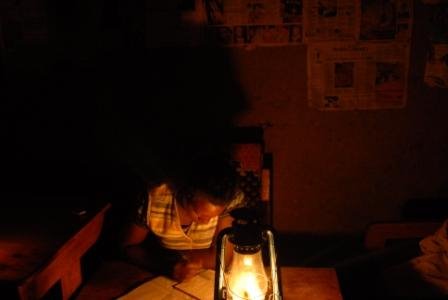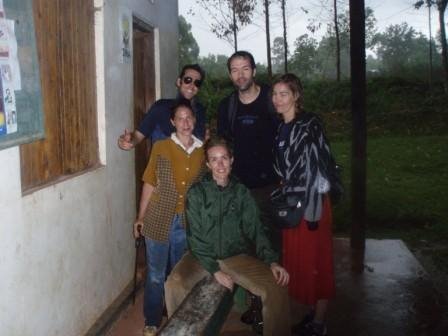Recently the Photo Essay Project was a featured topic at the local chapter of Earthcharter, a group that has adopted the parameters of the Kyoto Treaty promoting sustainable practices worldwide. http://www.earthcharter.org/ (check out the charter itself on one of the links. Good stuff!)
Other projects were featured from Vancouver, Canada and the Seattle and surrounding areas. We were all invited to share the individual work we have done towards promoting sustainable values.
Large changes in local and global communities are being made, and each started with a small step.
Kind Thanks to the EarthCharter organization for their attention and promotion.
The Monkeychatters also wanted to remind those of you who follow Annie Marie Musselman's photo work, that she has a current show at http://www.pcnw.org/gallery/schedule.php in First Hill, Seattle. It's called "A Delicate Balance." Try to get there--it's great!
Monkeychatters
Monday, May 14, 2007
Monday, April 16, 2007
Leather Hands and Feet
Squirrel monkeys scurry about, seeking pockets to filch with their little leathery hands and feet. On the nearby island there is nothing but a water trench between visitors and the Bonobo group. Thought to be the most intelligent kind of chimpanzee, the Bonobo are dissapearing rapidly from poaching, and are likely to be extinct within the next 10 years if the trend continues.
Welcome to Apenheul, http://www.goodzoos.com/Netherlands/Apenheul.htm a park one hour away from Amsterdam by train.
Janine's in town, so she's decided to visit the facility http://www.webshots.com/explore/Apenheul and see what she can learn.
It’s a place like a zoo, only if you want to walk through the park, you get a “monkey-proof” bag at the entrance, because the residents aren’t shy.
Do you know the ape, Washoe? She's bonobo, and lives at Western Washington University. She speaks in sign language, and has taught it to her children. http://www.friendsofwashoe.org/meet_the_family.shtml
Gorillas roam freely here. The recently-imported silverback Gorilla is just getting to know the group ladies this morning. He is young and brash, and pounds his chest to show off a bit. (just a typical teenager). Most of the ladies don't know quite what to think of him yet, but as he is really big and mighty powerful, they keep their distance and show him respect.
Speaking to the gorilla keeper for a while was great. He had been with the animals for twelve years, from the time that he started as a seasonal worker in his teens. He told us that Diane Fossey had visited once, and had invited a number of the keepers to come observe the gorillas with her for a full month in Rwanda. He went, and he said it was one of the best experiences of his life. Uganda is right beside Rwanda in Africa, and the forests connect together in places.
The Orangutan group was large.
Unlike Seattle's Woodland Park Zoo, which has hybrid orangutans (a genetic combination of Borneo and Sumatra bloodlines), these 14 (fourteen) Orangutan all came from Borneo or were born from parents who originated from there. They are a dark red-rouge color, and extra furry.
One orangutan mother we saw had her own child, and had adopted another from a mom that couldn't produce milk. She was hanging out nearby with the two kids wrapped around her hip and head, looking patient. "They are all so calm," Janine said--"do they really like strangers?"
The keeper shook his head 'no' with a smile and responded that he left all the decisions to the chief male, to whom Janine was introduced upon first entering the caging area. "If he doesn't like you, then I go with his decision, otherwise you're ok..."
...whew...
Meerkat, bush babies and other 'half monkey' types share your benches, and stare at you as you eat your ice cream. It's a little unerving at first.
Keepers stand back and look on.
The keeper functions more like a friend in the background rather than a trainer, disciplinarian or even a peer to the primate communities at Apenheul. Each of them explained their jobs, and the overwhelming impression was how much they loved the animals, and loved what they did.
The behind-the-scenes peeks into the facilities took 4 hours. At the end it was evident that this place was really about CONSERVATION. Overall it was a very peaceful spot on the planet (with occasional scuffles over who was going to get the orange slice at lunchtime.)
Included are some of the photos from the day, along with some webshots taken by other people found online. You'll enjoy the cheeky little buggers!
Welcome to Apenheul, http://www.goodzoos.com/Netherlands/Apenheul.htm a park one hour away from Amsterdam by train.
Janine's in town, so she's decided to visit the facility http://www.webshots.com/explore/Apenheul and see what she can learn.
It’s a place like a zoo, only if you want to walk through the park, you get a “monkey-proof” bag at the entrance, because the residents aren’t shy.
Do you know the ape, Washoe? She's bonobo, and lives at Western Washington University. She speaks in sign language, and has taught it to her children. http://www.friendsofwashoe.org/meet_the_family.shtml
Gorillas roam freely here. The recently-imported silverback Gorilla is just getting to know the group ladies this morning. He is young and brash, and pounds his chest to show off a bit. (just a typical teenager). Most of the ladies don't know quite what to think of him yet, but as he is really big and mighty powerful, they keep their distance and show him respect.
Speaking to the gorilla keeper for a while was great. He had been with the animals for twelve years, from the time that he started as a seasonal worker in his teens. He told us that Diane Fossey had visited once, and had invited a number of the keepers to come observe the gorillas with her for a full month in Rwanda. He went, and he said it was one of the best experiences of his life. Uganda is right beside Rwanda in Africa, and the forests connect together in places.
The Orangutan group was large.
Unlike Seattle's Woodland Park Zoo, which has hybrid orangutans (a genetic combination of Borneo and Sumatra bloodlines), these 14 (fourteen) Orangutan all came from Borneo or were born from parents who originated from there. They are a dark red-rouge color, and extra furry.
One orangutan mother we saw had her own child, and had adopted another from a mom that couldn't produce milk. She was hanging out nearby with the two kids wrapped around her hip and head, looking patient. "They are all so calm," Janine said--"do they really like strangers?"
The keeper shook his head 'no' with a smile and responded that he left all the decisions to the chief male, to whom Janine was introduced upon first entering the caging area. "If he doesn't like you, then I go with his decision, otherwise you're ok..."
...whew...
Meerkat, bush babies and other 'half monkey' types share your benches, and stare at you as you eat your ice cream. It's a little unerving at first.
Keepers stand back and look on.
The keeper functions more like a friend in the background rather than a trainer, disciplinarian or even a peer to the primate communities at Apenheul. Each of them explained their jobs, and the overwhelming impression was how much they loved the animals, and loved what they did.
The behind-the-scenes peeks into the facilities took 4 hours. At the end it was evident that this place was really about CONSERVATION. Overall it was a very peaceful spot on the planet (with occasional scuffles over who was going to get the orange slice at lunchtime.)
Included are some of the photos from the day, along with some webshots taken by other people found online. You'll enjoy the cheeky little buggers!
Thursday, April 12, 2007
Homeward Bound
The time has come to bid goodbye to Africa, as the team leaves the continent. For the next five months, the project will be running with only local participation, leadership and motivation.
Becka and Michael will be touring the United States from east to west visiting friends and relatives, and being special guests at events surrounding support of the important work we all hope to continue in Uganda. They will return in September 2007 for another year.
Annie and Josh will be returning to Seattle where Annie begins the long and laborous task of developing, sorting, editing and printing photo selections reflecting key moments of the time abroad. Good luck Annie, and good work!
At some point in the future, we hope to share these with all the families, friends, coworkers, and supporters--our special community surrounding this important conservation effort!
Janine returns to Seattle a few days after Annie and Josh. She'll be stopping over in Amsterdam, Netherlands to have the stitches removed from her right knee.
...what, you didn't hear about that?!???#*#*#*#%*
It was the day she and her crew flipped the raft upside down in the center of a class-5 rapid on the Nile. She's pretty excited to see what the scar looks like, and to tell the story to her grandkids...
"Back when granny had teeth," she'll say,
"She was rafting on the Nile River in Africa..." (sounds pretty impressive, eh?). "
"...and here's the scar from the stitches..."
She's already started queries to magazines to see if they will consider articles about the events overseas.
As we wash the smell of African morning campfires out of our hair at the hotel prior to departure, we are reminded of the sights and sounds of a land rich and fertile with a smoky skyline--vibrating with activity. The clothes we bring home have a strange perfume, exotic and warm, making our memories more vivid, and our comfortable beds, indoor plumbing, plentiful food and electricity seem strange and foreign.
Our busy lives will change a little because of the new things we have known and seen.
Becka and Michael will be touring the United States from east to west visiting friends and relatives, and being special guests at events surrounding support of the important work we all hope to continue in Uganda. They will return in September 2007 for another year.
Annie and Josh will be returning to Seattle where Annie begins the long and laborous task of developing, sorting, editing and printing photo selections reflecting key moments of the time abroad. Good luck Annie, and good work!
At some point in the future, we hope to share these with all the families, friends, coworkers, and supporters--our special community surrounding this important conservation effort!
Janine returns to Seattle a few days after Annie and Josh. She'll be stopping over in Amsterdam, Netherlands to have the stitches removed from her right knee.
...what, you didn't hear about that?!???#*#*#*#%*
It was the day she and her crew flipped the raft upside down in the center of a class-5 rapid on the Nile. She's pretty excited to see what the scar looks like, and to tell the story to her grandkids...
"Back when granny had teeth," she'll say,
"She was rafting on the Nile River in Africa..." (sounds pretty impressive, eh?). "
"...and here's the scar from the stitches..."
She's already started queries to magazines to see if they will consider articles about the events overseas.
As we wash the smell of African morning campfires out of our hair at the hotel prior to departure, we are reminded of the sights and sounds of a land rich and fertile with a smoky skyline--vibrating with activity. The clothes we bring home have a strange perfume, exotic and warm, making our memories more vivid, and our comfortable beds, indoor plumbing, plentiful food and electricity seem strange and foreign.
Our busy lives will change a little because of the new things we have known and seen.
Monday, April 9, 2007
Divide and Conquer
It's about the chimps! We don't have enough time to do it all, and the time to fly home is fast approaching.
Annie and Josh have landed near Kampala at the N'Gamba Island chimp facility, and Janine has gone north to the source of the Nile river. Annie and Josh travel home the next day. Safe travels, you two!
http://www.ventureco-worldwide.com/jinja_chimpanzee_project2.htm.
Both facilities are managed by Cam Macleay in Uganda, who owns the “Adrift” whitewater rafting company in Jinja. Janine will be staying at his base camp along the Nile banks for a week and braving the white water to get to Kalagala Island.
Kalagala Island (actually two islands) is the newest facility for abandoned chimps whose parents have been lost to poachers or as casualties of the bush meat trade. We are looking forward to learning about how orphaned chimps are cared for.
It is Easter here, so people celebrate by relaxing the week before and the few days after. That means everything basically stops moving. It's really hit and miss with supplies and chapati. It's a good time to catch up on journals and have a look at the photos so far.
What's chapati? Ugandan comfort food--a round, puffy tortilla made from millet flour and lots of oil and salt, grilled over an open flame. It's completely addictive and incredibly yummy, especially when made in front of you and served warm. It tastes alot like indian naan and sells for a few cents each. Hmmm.
Monkeychatters
Annie and Josh have landed near Kampala at the N'Gamba Island chimp facility, and Janine has gone north to the source of the Nile river. Annie and Josh travel home the next day. Safe travels, you two!
http://www.ventureco-worldwide.com/jinja_chimpanzee_project2.htm.
Both facilities are managed by Cam Macleay in Uganda, who owns the “Adrift” whitewater rafting company in Jinja. Janine will be staying at his base camp along the Nile banks for a week and braving the white water to get to Kalagala Island.
Kalagala Island (actually two islands) is the newest facility for abandoned chimps whose parents have been lost to poachers or as casualties of the bush meat trade. We are looking forward to learning about how orphaned chimps are cared for.
It is Easter here, so people celebrate by relaxing the week before and the few days after. That means everything basically stops moving. It's really hit and miss with supplies and chapati. It's a good time to catch up on journals and have a look at the photos so far.
What's chapati? Ugandan comfort food--a round, puffy tortilla made from millet flour and lots of oil and salt, grilled over an open flame. It's completely addictive and incredibly yummy, especially when made in front of you and served warm. It tastes alot like indian naan and sells for a few cents each. Hmmm.
Monkeychatters
Wednesday, April 4, 2007
More Answers
We have no idea how many species of animals that are here in the Kibale National Forest.
If you are just counting insects alone, it is into the millions--and there are lots that don't have names, and researches are finding for the first time. We average 3-5 bites. We wear sleeves, so when we are treking they climb your pants and bite on the seams..but we are doing ok!
There are reptiles like poisonous vipers (the black mambo is the most popular, and the cobra), as well as snakes with teeth that live in the trees (the brown banded tree snake and the mole snake that has a flat snout, and a local one called the 'eyelash snake' that we couldn't find in a book--he has a row of scales over his eyes that bulge like frogs, and he's electric green.) The eyelash loops himself around vines that wind around tree trunks. When you are in the forest, be careful where you put your hands. They like to perch at shoulder level so they have a good view.
There are whole books on the birds with names like the 'African fish eagle' (looks like the American bald eagles but bigger). There are herons, egrets, swallows, finches, and huge storks--the Uganda national bird. http://www.etg-safaris.com/ug.htm (check out the bird on this safari ad)
There are hummingbirds and colored whatchamacallits and bats that fly around your head at night (we have a family of four that lives in our kitchen that is the same species as the ones in the Woodland Park Zoo nocturnal house). There are over 300 species of birds in Mabira Forest alone, which is near to us. http://www.credit-uganda.com/mabira.htm. This site has birding tours, so you can look at all the colors.
Why do the chimps change their diet everyday?
Chimps don't like to eat the same foods, and sometimes they need different minerals, so they change according to what they crave. If you had to eat peanut butter and jelly every day, eventually you'd get tired of it, right? They like beans that grow in trees and different fruits, bark and leaves, and sometimes insects for protien. They really like ants. Really...the chimps we saw just 'get crazy' over them. The Gorillas did too. We were told that local people eat a bean sauce made with 'g-nuts" (peanuts), and that they will also drop the ants in for flavor and cook them up. Annie and Janine love the g-nut sauce, but without ants, thank you very much!
We have seen 9 kinds of primates so far, apes (no tails) and monkeys (have tails). The chimps we saw would be as tall as your teacher's shoulder if they stood on hind feet, and many times stronger than the stongest man by the time they are teenagers. The babies range from basketball size to knee-high.
Are there schools?
Yes, each village has state schools, and there are private schools in the larger city. Our local schools has about 150 kids. You have to pay for your uniform and your books to go to any of the state schools, but grade school is free. Everyone is charged tuition in middle school, high school and college. For us, it costs about $3,000 for one year to go to middle school, but the people are very poor here. Most kids drop out after grade school to help their parents farm and raise other children, and because they cannot afford it.
When a Ugandan asks you for money, it's usually for a scholarship to continue school. They know that their education is a key to a good job and future.
For some perspective, if a mom makes $3.00 from selling potatoes one day, she affords to feed her family for three days and is happy.
What is your favorite thing about the trip so far?
We have liked so many things so far, but the people here have to be our favorite. They are warm and generous with each other and strangers. They work together as teams, and even old people still contribute to the family. As Americans, we are sometimes a little embarrassed by any complaint, since very few kids even have shoes. We have learned how lucky we are.
We also like matooke (ma-toke-eh), which looks like a banana and tastes like a baked potato. It's served steamed in banana leaves. It's good with g-nut sauce.
Waking up to the chatter of the monkeys is great too--you try to imagine what they are saying to each other, and to watch them play in the mornings--tossing branches and swinging around, you wish you could have so much fun just hanging around in trees...
What's the biggest difference between living there and here?
no bathtubs and you always carry your own tissue. (oh, man, are you serious??? Yep.--back to nature.)
Thank you for the questions!
Monkeychatters
If you are just counting insects alone, it is into the millions--and there are lots that don't have names, and researches are finding for the first time. We average 3-5 bites. We wear sleeves, so when we are treking they climb your pants and bite on the seams..but we are doing ok!
There are reptiles like poisonous vipers (the black mambo is the most popular, and the cobra), as well as snakes with teeth that live in the trees (the brown banded tree snake and the mole snake that has a flat snout, and a local one called the 'eyelash snake' that we couldn't find in a book--he has a row of scales over his eyes that bulge like frogs, and he's electric green.) The eyelash loops himself around vines that wind around tree trunks. When you are in the forest, be careful where you put your hands. They like to perch at shoulder level so they have a good view.
There are whole books on the birds with names like the 'African fish eagle' (looks like the American bald eagles but bigger). There are herons, egrets, swallows, finches, and huge storks--the Uganda national bird. http://www.etg-safaris.com/ug.htm (check out the bird on this safari ad)
There are hummingbirds and colored whatchamacallits and bats that fly around your head at night (we have a family of four that lives in our kitchen that is the same species as the ones in the Woodland Park Zoo nocturnal house). There are over 300 species of birds in Mabira Forest alone, which is near to us. http://www.credit-uganda.com/mabira.htm. This site has birding tours, so you can look at all the colors.
Why do the chimps change their diet everyday?
Chimps don't like to eat the same foods, and sometimes they need different minerals, so they change according to what they crave. If you had to eat peanut butter and jelly every day, eventually you'd get tired of it, right? They like beans that grow in trees and different fruits, bark and leaves, and sometimes insects for protien. They really like ants. Really...the chimps we saw just 'get crazy' over them. The Gorillas did too. We were told that local people eat a bean sauce made with 'g-nuts" (peanuts), and that they will also drop the ants in for flavor and cook them up. Annie and Janine love the g-nut sauce, but without ants, thank you very much!
We have seen 9 kinds of primates so far, apes (no tails) and monkeys (have tails). The chimps we saw would be as tall as your teacher's shoulder if they stood on hind feet, and many times stronger than the stongest man by the time they are teenagers. The babies range from basketball size to knee-high.
Are there schools?
Yes, each village has state schools, and there are private schools in the larger city. Our local schools has about 150 kids. You have to pay for your uniform and your books to go to any of the state schools, but grade school is free. Everyone is charged tuition in middle school, high school and college. For us, it costs about $3,000 for one year to go to middle school, but the people are very poor here. Most kids drop out after grade school to help their parents farm and raise other children, and because they cannot afford it.
When a Ugandan asks you for money, it's usually for a scholarship to continue school. They know that their education is a key to a good job and future.
For some perspective, if a mom makes $3.00 from selling potatoes one day, she affords to feed her family for three days and is happy.
What is your favorite thing about the trip so far?
We have liked so many things so far, but the people here have to be our favorite. They are warm and generous with each other and strangers. They work together as teams, and even old people still contribute to the family. As Americans, we are sometimes a little embarrassed by any complaint, since very few kids even have shoes. We have learned how lucky we are.
We also like matooke (ma-toke-eh), which looks like a banana and tastes like a baked potato. It's served steamed in banana leaves. It's good with g-nut sauce.
Waking up to the chatter of the monkeys is great too--you try to imagine what they are saying to each other, and to watch them play in the mornings--tossing branches and swinging around, you wish you could have so much fun just hanging around in trees...
What's the biggest difference between living there and here?
no bathtubs and you always carry your own tissue. (oh, man, are you serious??? Yep.--back to nature.)
Thank you for the questions!
Monkeychatters
Tuesday, April 3, 2007
Questions and Answers
Thank you third and fourth graders for the questions you sent to us last week. We are gathering the answers.
Until then please enjoy the new pictures we've just added. We all laughed at one very interesting question about the chimps. Someone said "when the fruit hit you on the head, did it hurt?"
Well, it was surprising, but it did not hurt. The fruit was a fig, about the side of a large marble. Since they were looking for the ripe ones, the apes would toss down the unripe green kind, but they only weigh as much as a a bottle cap.
We also enjoyed the questions about insects. You cannot IMAGINE how many insects there are here--mosquitos, beetles, mango flies that lay eggs in your socks when you leave them outside and prefer the tastes of certain colors (Annie's socks with pink hearts were their favorite), ants as big a piece of long-grain rice and that HURT when they get up your pants, grasshoppers the size of your thumb (if you are a local, you catch them and fry them up for snacks), knats, praying mantis, butterflies, and oh...did we mention mosquitos?!?
Monkeychatters
Until then please enjoy the new pictures we've just added. We all laughed at one very interesting question about the chimps. Someone said "when the fruit hit you on the head, did it hurt?"
Well, it was surprising, but it did not hurt. The fruit was a fig, about the side of a large marble. Since they were looking for the ripe ones, the apes would toss down the unripe green kind, but they only weigh as much as a a bottle cap.
We also enjoyed the questions about insects. You cannot IMAGINE how many insects there are here--mosquitos, beetles, mango flies that lay eggs in your socks when you leave them outside and prefer the tastes of certain colors (Annie's socks with pink hearts were their favorite), ants as big a piece of long-grain rice and that HURT when they get up your pants, grasshoppers the size of your thumb (if you are a local, you catch them and fry them up for snacks), knats, praying mantis, butterflies, and oh...did we mention mosquitos?!?
Monkeychatters
Saturday, March 31, 2007
Mazungus in the Mist
We've taken a side trip.
With the encouragement of our sponsors, we've taken a few days to travel to the south of Uganda. The road is the main highway also leading to the Republic of Congo, and the traffic is a little notorious, so we hired a local guide to get us through the rough spots, including the 250 miles between here and the mountain gorillas in Bwindi, and the 12 hours it takes to get there along the dusty, muddy unpaved road through Queen Elizabeth National Park. http://www.kilimanjaro.com/uganda/qenp.htm
This park joins Kibale and extends further to the south.
We're not kidding when we say this road had potholes. In fact, some were hip-deep on an adult, and we all felt like jello by the end of the day. We were unable to get out of the car for various reasons until the main part of the trip was completed, but mostly due to the cape buffalo, lions, african kab, waterbuck, wild boar, hyena, elephants running amok...you get the picture--lots of animals. You can't just stroll down the road in rural Uganda--you'll be someone's dinner.
Bwindi Forest was incredible. Steep mountain peaks hovering in clouds, breezes cool and brisk, lush green mist with everything growing on everything, and lastly, the gorillas at the end of a grueling 3 hour hike on mountain switchbacks. We came face to face with the gentle giants almost hunted to extention less than 30 years ago, and it was a life-changing experience. We sat among them for an hour as their children played, the silverback looked on with wary interest at the white monkeys staring at his family. They are so like us. Looking into their faces and seeing the intelligence was beautiful.
After two nights in the dripping, vibrant freshness we headed back towards Kampala, stopping at a Safari Lodge on the way posted with armed guards. (So close to the Congo, it is necessary for tourist safety, and to keep we Americans from wandering down the road to far into imminent danger). Members of the Ugandan Wildlife Authority also stay with us there.
We saw the hippos the following afternoon, waddling and eating, soaking and spraying, yawning and yawning and YAWNING from the cool water of the nearby lake.
We all wanted to jump into the cool water from the boat--into the channel that connects Lake Albert and Lake George within the confines of the park. The people from the fishing villages lined the banks, and looked like they were having such a good time bathing, washing clothes and filling bottles of the wet stuff--but we couldn't. Unfortunately the water bodies in Uganda have a snail larvae that burrows under the skind and gives foreigners a disease called schistosomiasis (Belharzia). Areas with reed beds, stagnant water, and/or high human use are the most likely places to catch it. The disease can last for up to 20 years, and as locals don't mind, few Americans can learn to be okay with the idea of worms mating in our bodies until our brains turn to mush. Yeah--so, no swimming for the monkechatters.
However, we saw over thirty species of birds, and crocodiles sunning themselves with open mouths--some 14ft long at least. The cape buffalo sat in the shallow water and stared at us as we floated by, and some moved if we came to close. It was like the Jungle ride at Disney--but much, much better!
We left for Kampala the next morning. After 9 hours of the Bwindi-Congo road, we arrived in the capital city where, as far as we can tell, the horn is the only form of government. Cars all converge into and intersection at once, facing off and honking. Instead of waving each other on, they just honk...for a while.
If you have a bigger horn or a slippery driver (like the mutatu taxi drivers...the white mini-vans with people, chickens and luggage streaming out all windows and over capacity by at least 6 people) you seem to travel faster from place to place.
There is also the motorcycle taxi, called a bodaboda--the cheapest way to get anywhere, and the most sure way to land in the hospital for their penchant to cut through the space between car bumpers stacked in a waiting line. If chosing to ride on a bodaboda, you learn to say to the driver sternly 'Sir, if any part of my body even slightly grazes an object, YOU DON'T get paid, understand?!?!?" sometimes you get lucky and they do pay attention...
At rest in a Kampala hotel with running water and a comfy bed (we are all so shocked) we hardly know what to do with ourselves. We may actually have a cold softdrink...and ice (such luxury) before we head back south to Kanyawara Village. The girls took long baths and then jumped up and down on the beds.
Monkeychatters
With the encouragement of our sponsors, we've taken a few days to travel to the south of Uganda. The road is the main highway also leading to the Republic of Congo, and the traffic is a little notorious, so we hired a local guide to get us through the rough spots, including the 250 miles between here and the mountain gorillas in Bwindi, and the 12 hours it takes to get there along the dusty, muddy unpaved road through Queen Elizabeth National Park. http://www.kilimanjaro.com/uganda/qenp.htm
This park joins Kibale and extends further to the south.
We're not kidding when we say this road had potholes. In fact, some were hip-deep on an adult, and we all felt like jello by the end of the day. We were unable to get out of the car for various reasons until the main part of the trip was completed, but mostly due to the cape buffalo, lions, african kab, waterbuck, wild boar, hyena, elephants running amok...you get the picture--lots of animals. You can't just stroll down the road in rural Uganda--you'll be someone's dinner.
Bwindi Forest was incredible. Steep mountain peaks hovering in clouds, breezes cool and brisk, lush green mist with everything growing on everything, and lastly, the gorillas at the end of a grueling 3 hour hike on mountain switchbacks. We came face to face with the gentle giants almost hunted to extention less than 30 years ago, and it was a life-changing experience. We sat among them for an hour as their children played, the silverback looked on with wary interest at the white monkeys staring at his family. They are so like us. Looking into their faces and seeing the intelligence was beautiful.
After two nights in the dripping, vibrant freshness we headed back towards Kampala, stopping at a Safari Lodge on the way posted with armed guards. (So close to the Congo, it is necessary for tourist safety, and to keep we Americans from wandering down the road to far into imminent danger). Members of the Ugandan Wildlife Authority also stay with us there.
We saw the hippos the following afternoon, waddling and eating, soaking and spraying, yawning and yawning and YAWNING from the cool water of the nearby lake.
We all wanted to jump into the cool water from the boat--into the channel that connects Lake Albert and Lake George within the confines of the park. The people from the fishing villages lined the banks, and looked like they were having such a good time bathing, washing clothes and filling bottles of the wet stuff--but we couldn't. Unfortunately the water bodies in Uganda have a snail larvae that burrows under the skind and gives foreigners a disease called schistosomiasis (Belharzia). Areas with reed beds, stagnant water, and/or high human use are the most likely places to catch it. The disease can last for up to 20 years, and as locals don't mind, few Americans can learn to be okay with the idea of worms mating in our bodies until our brains turn to mush. Yeah--so, no swimming for the monkechatters.
However, we saw over thirty species of birds, and crocodiles sunning themselves with open mouths--some 14ft long at least. The cape buffalo sat in the shallow water and stared at us as we floated by, and some moved if we came to close. It was like the Jungle ride at Disney--but much, much better!
We left for Kampala the next morning. After 9 hours of the Bwindi-Congo road, we arrived in the capital city where, as far as we can tell, the horn is the only form of government. Cars all converge into and intersection at once, facing off and honking. Instead of waving each other on, they just honk...for a while.
If you have a bigger horn or a slippery driver (like the mutatu taxi drivers...the white mini-vans with people, chickens and luggage streaming out all windows and over capacity by at least 6 people) you seem to travel faster from place to place.
There is also the motorcycle taxi, called a bodaboda--the cheapest way to get anywhere, and the most sure way to land in the hospital for their penchant to cut through the space between car bumpers stacked in a waiting line. If chosing to ride on a bodaboda, you learn to say to the driver sternly 'Sir, if any part of my body even slightly grazes an object, YOU DON'T get paid, understand?!?!?" sometimes you get lucky and they do pay attention...
At rest in a Kampala hotel with running water and a comfy bed (we are all so shocked) we hardly know what to do with ourselves. We may actually have a cold softdrink...and ice (such luxury) before we head back south to Kanyawara Village. The girls took long baths and then jumped up and down on the beds.
Monkeychatters
Subscribe to:
Posts (Atom)
